
The skimmers or perchers and their relatives form the Libellulidae, the largest dragonfly family in the world. It is sometimes considered to contain the Corduliidae as the subfamily Corduliinae and the Macromiidae as the subfamily Macromiinae. Even if these are excluded, there remains a family of over 1000 species. With nearly worldwide distribution, these are almost certainly the most often seen of all dragonflies.
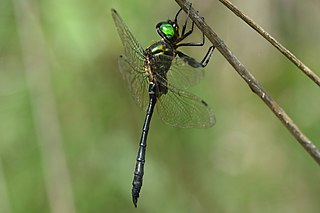
Corduliidae, also knowns as the emeralds, emerald dragonflies, or green-eyed skimmers, is a family of dragonflies. These dragonflies are usually black or dark brown with areas of metallic green or yellow, and most of them have large, emerald-green eyes. The larvae are black, hairy-looking, and usually semiaquatic. This family include species called "baskettails", "emeralds", "sundragons", "shadowdragons", and "boghaunters". They are not uncommon and are found nearly worldwide, but some individual species are quite rare. Hine's emerald dragonfly, for example, is an endangered species in the United States.

The insect family Coenagrionidae is placed in the order Odonata and the suborder Zygoptera. The Zygoptera are the damselflies, which although less known than the dragonflies, are no less common. More than 1,300 species are in this family, making it the largest damselfly family. The family Coenagrionidae has six subfamilies: Agriocnemidinae, Argiinae, Coenagrioninae, Ischnurinae, Leptobasinae, and Pseudagrioninae.

The Platycnemididae are a family of damselflies. They are known commonly as white-legged damselflies. There are over 400 species native to the Old World. The family is divided into several subfamilies.

Agriocnemis is a genus of damselfly in the family Coenagrionidae. Agriocnemis is distributed widely across Africa, South-east Asia, Indonesia, Australia and islands in the Pacific. They are small insects, commonly known as wisps.

Ceriagrion is a genus of damselfly in the family Coenagrionidae. Species of Ceriagrion are small to medium size, generally brightly coloured damselflies. They are found across the Old World, Africa, Asia and Australia.

Gynacantha is a genus of dragonflies in the family Aeshnidae. The females have two prominent spines under the last abdominal segment. This gives the genus name and the common name two-spined darners; they are also known as duskhawkers.
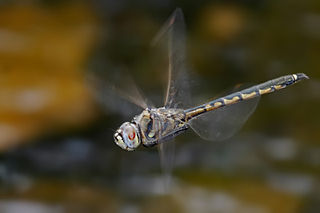
Hemicordulia is a genus of dragonfly in family Corduliidae. It occurs in Africa, southern Asia, Australasia and Pacific Islands such as the Bonin Islands, Fiji and French Polynesia. Species of Hemicordulia are small to medium-sized dragonflies, coloured black or metallic, with yellow.

Indolestes is a genus of damselflies in the family Lestidae. Species of Indolestes can be medium-sized, dull coloured dragonflies. They are found from India through Asia, Australia and the Pacific.
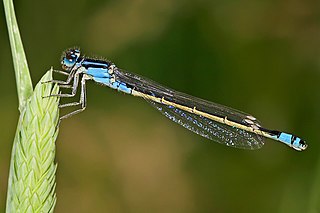
Ischnura is a genus of damselflies known as forktails in the family Coenagrionidae. Forktails are distributed worldwide, including various oceanic islands. The males have a forked projection at the tip of the abdomen which gives the group their common name.

Paragomphus is a genus of dragonfly in the family Gomphidae. They are commonly known as hooktails.
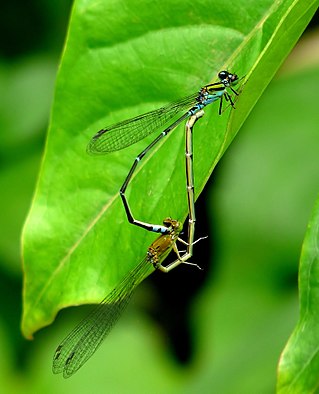
Pseudagrion is the largest genus of damselfly in the family Coenagrionidae, with over 140 species. Its range includes most of Africa, much of Asia, and Australia. Africa holds most of the diversity with almost 100 species. It has occupied most of the freshwater habitats in its range, and dominates damselfly communities in habitats as different as desert pools, equatorial rainforests and montane streams.

Rhinocypha is a genus of damselflies in the family Chlorocyphidae.

Tramea is a genus of dragonflies in the family Libellulidae, the skimmers and perchers. Species of Tramea are found in tropical and subtropical regions around the globe. They typically have colored bases to their otherwise translucent hindwings. In particular when they fly, this creates the impression of their carrying bags at the start of their abdomens. They are known commonly as saddlebags or saddlebags gliders.
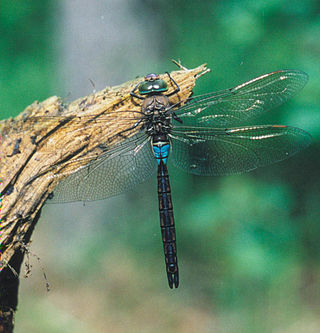
Anax is a genus of dragonflies in the family Aeshnidae. It includes species such as the emperor dragonfly, Anax imperator.

Agrionoptera is a genus of dragonflies in the family Libellulidae. Species of Agrionoptera are found across India, Southeast Asia and the Pacific.

Nannophlebia is a genus of dragonfly in the family Libellulidae. They are commonly known as Archtails. The species are very small with black and yellow striped abdomens.
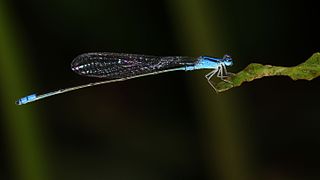
Archibasis is a genus of damselflies belonging to the family Coenagrionidae. These damselflies are generally medium-sized with bright colouring. Archibasis occurs in southern Asia, Indonesia, New Guinea and Australia.

Austroagrion is a genus of damselflies belonging to the family Coenagrionidae. Species of Austroagrion are small damselflies; males are black with blue or green markings while females are paler. Austroagrion occurs in Papua New Guinea, New Caledonia and Australia.



















